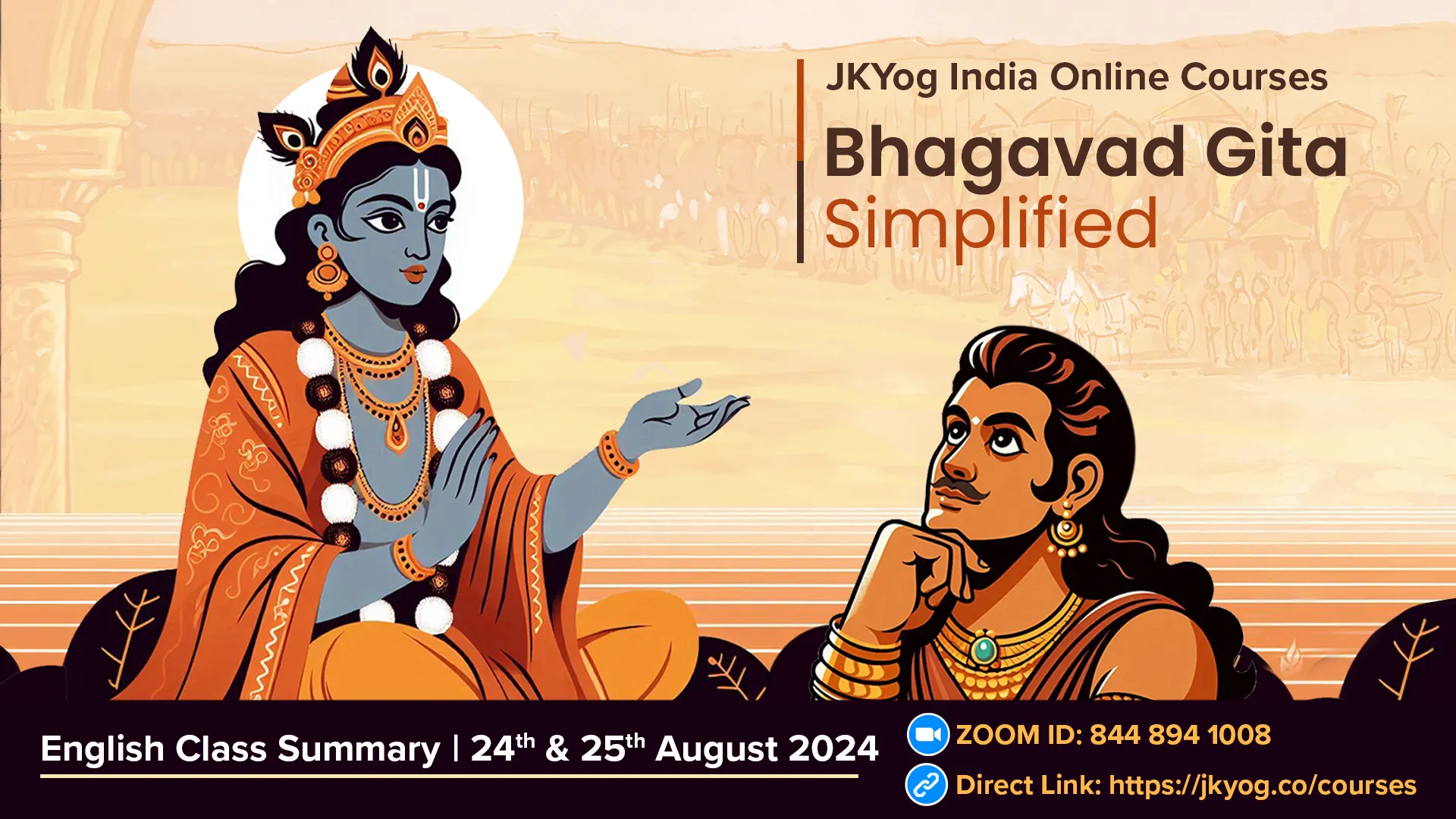In Classes 5 and 6 of the JKYog Online Class on 'Bhagavad Gita Simplified,' we explored essential teachings and concepts from the Bhagavad Gita. Class 5 delved into the inevitability of action and the misconception of inaction, emphasising the significance of performing duties selflessly and understanding the true essence of action. We examined the categorisations of actions into Karm, Vikarm, and Akarm and discussed the principles of Karm Yog and Karm Sanyas, highlighting their relevance in spiritual practice. In Class 6, we continued to explore the inevitability of action and the path of Karm Yog, emphasising the superiority of selfless action over mere renunciation. We also discussed the divine knowledge imparted by Shree Krishna, His incarnations, and the nature of divine actions, underscoring the importance of understanding and embodying these principles in our daily lives.
Inescapability of Action
In the Bhagavad Gita, Shree Krishna explains that action is inescapable for everyone. The verse states:
न हि कश्चित्क्षणमपि जातु तिष्ठत्यकर्मकृत् |
कार्यते ह्यवश: कर्म सर्व: प्रकृतिजैर्गुणै: ||
No one can remain without action, even for a moment. Indeed, all beings are compelled to act by their qualities born of material nature (the three guṇas). (Gita 3.5)
This verse highlights that action is a fundamental aspect of existence, driven by the three gunas: sattva (goodness), rajas (passion), and tamas (ignorance). Even when one attempts to avoid action, one's mind and body remain engaged in some form of activity.
Renouncing Profession: Misconceptions about Inaction
Renouncing professional work does not equate to inaction. Action encompasses much more than just one's profession. It includes daily activities such as eating, drinking, sleeping, waking, and even thinking. All activities involving the body, mind, and tongue are considered actions.
- Physical Activities: Sitting or lying down is also an activity.
- Mental Activities: Even in sleep, the mind engages in dreams, and bodily organs function during deep sleep.
The body-mind-intellect mechanism, influenced by the three gunas, is constantly active. Hence, complete inactivity is an unattainable state.
Performing Duties Without Attachment
Act Selflessly Without Desiring Outcomes
Shree Krishna emphasises the importance of performing one's duties selflessly:
नियतं कुरु कर्म त्वं कर्म ज्यायो ह्यकर्मण: |
शरीरयात्रापि च ते न प्रसिद्ध्येदकर्मण: ||
You should thus perform your prescribed Vedic duties since action is superior to inaction. By ceasing activity, even your bodily maintenance will not be possible. (Gita 3.8)
Work must be done as a yajna (sacrifice) to the Supreme Lord. Otherwise, work binds one to material existence. Therefore, for the satisfaction of God, perform your prescribed duties without attachment to the results. (Gita 3.9)
Work done for internal purification and spiritual growth helps cleanse the mind and intellect, leading to God-consciousness. The Vedas stress discipline in performing duties to avoid laziness, which is seen as a major obstacle in spiritual progress. Laziness is considered a severe internal enemy, with work acting as a safeguard against it.
Nitya Karm (Obligatory Actions)
Basic activities such as eating and bathing, which are necessary for maintaining health, should not be neglected. These actions contribute to overall well-being and spiritual progress.
Work performed with a sense of detachment and dedication aids in spiritual advancement and prevents inertia, which can hinder both material and spiritual achievements.
Work as a Yajna (Sacrifice)
Intent Behind Work
Just as a knife can be used for both harm and healing, the impact of work depends on its intent. Work performed for personal gratification results in bondage, while work done as a sacrifice to God leads to liberation.
Inescapability of Action
Humans are bound by nature to act. The choice lies in whether to work for personal gratification or as a sacrifice to God.
Example of King Raghu: King Raghu's selfless sacrifice during the Viśhwajit ceremony, where he donated all his possessions, demonstrates the ideal of viewing everything as belonging to God and dedicating actions to His service.
Three Categories of Action
Karm, Vikarm, and Akarm
Shree Krishna categorises actions into three types:
किं कर्म किमकर्मेति कवयोऽप्यत्र मोहिता: |
तत्ते कर्म प्रवक्ष्यामि यज्ज्ञात्वा मोक्ष्यसेऽशुभात् ||
What is action, and what is inaction? Even the wise are confused when determining this. Now I shall explain to you the secret of action; by knowing which, you may free yourself from material bondage. (Gita 4.16)
- Karm (Right Action): Actions performed in alignment with dharma lead to positive outcomes. The scriptures recommend these auspicious actions for regulating the senses and purifying the mind.
- Vikarm (Wrong Action): Actions against dharma have negative consequences. These inauspicious actions, prohibited by scriptures, degrade the soul.
- Akarm (Inaction in Action): Actions performed without attachment to results, dedicated to God. These actions do not create karmic reactions and do not entangle the soul.
Action in Inaction and Inaction in Action
Those who perceive action in inaction and inaction in action are considered truly wise. Though they perform all kinds of actions, they master their actions and are known as yogis. (Gita 4.18)
- Action in Inaction: Some people, while appearing inactive, are actually engaged in sinful actions by their thoughts and intentions. When Arjun wished to avoid his duty, Shree Krishna explained that such inaction would lead to sin and undesirable consequences.
- Inaction in Action: Karm yogis perform their duties selflessly without attachment to results, dedicating their actions to God. They are not entangled in karmic reactions, as their motive is solely for spiritual service.
Karm Yog (Selfless Action)
Engaging in action without attachment to outcomes and performing duties as a service or sacrifice to God is termed Karm Yog. Great kings like Dhruv, Prahlad, Yudhisthir, Prithu, and Ambarish performed their duties selflessly, illustrating the principles of Karm Yog.
Karm Sanyas (Renunciation of Action)
Renouncing Worldly Activities
Karm sanyās is for those who have transcended bodily attachment and focus entirely on spiritual duties. A karm sanyāsī dedicates their life to devotional service, while a karm yogi balances social and spiritual duties.
Karm Yog vs. Karm Sanyas
A karm yogi splits time between worldly and spiritual duties, whereas a karm sanyāsī dedicates full time to spirituality. Karm Yog is considered safer for most, as it allows for the continuation of worldly responsibilities while practicing spiritual detachment.
Krishna's Verdict: Both Karm Sanyas and Karm Yog lead to liberation, but Karm Yog is superior. Karm sanyāsīs may face risks if they cannot maintain spiritual focus, whereas karm yogis have the safeguard of their duties to support their spiritual journey. (Gita 5.2)
Example of King Janaka: King Janaka attained liberation while fulfilling his worldly duties, setting an example for others. Shree Krishna recommends that Arjun follow this path of Karm Yog to demonstrate the importance of performing one's duties for the betterment of society. (Gita 3.20-21)
True Renunciation
Renunciation involves detachment from desires rather than avoiding action. Those who perform their duties without desiring the results are true sanyāsīs and yogis. True sanyās is synonymous with Yog, as both require renunciation of worldly desires. (Gita 6.1-2)
On Day 6, we further explored the concept of action, focusing on Karm (right action), Vikarm (wrong action), and Akarm (inaction in action). We highlighted the significance of performing duties selflessly and the superiority of Karm Yog over Karm Sanyas. The teachings emphasised that true renunciation involves detachment from the results of actions rather than mere cessation of activities. We also discussed Shree Krishna's divine knowledge, His incarnations, and the nature of divine actions, illustrating how understanding and aligning with these principles can enhance spiritual growth and devotion.
Performing Duties Without Attachment
- Karm: Right action performed in line with dharma, leading to positive outcomes.
- Vikarm: Wrong action that is against dharma, leading to negative consequences.
- Akarm: Inaction in action, where one performs duties without creating karmic reactions due to detachment.
Karm Sanyas (Renunciation of Action)
The paths of Renunciation (Karm Sanyas) and Devotion (Karm Yog) both lead to the supreme goal, but Karm Yog is considered superior.
Importance of Karm Yog: Even if one's mind turns away from spirituality, performing duties ensures that followers continue their responsibilities, aiding in self-discipline and spiritual growth.
Shree Krishna's Teachings on Action
Shree Krishna emphasises that even though He has no personal duty or gain, He engages in prescribed duties (Gita 3.22).
True Renunciation
Real renunciation is about detachment from the results of actions, not merely ceasing bodily activities or sacrifices (Gita 6.1, 6.2).
Divine Knowledge and Descension
Transmission of Knowledge
Shree Krishna reveals that He taught the science of Yog to Vivasvan, the Sun God, and it was passed down through generations (Gita 4.1-4.4).
Reasons for Divine Incarnation
यदा यदा हि धर्मस्य ग्लानिर्भवति भारत |
अभ्युत्थानमधर्मस्य तदात्मानं सृजाम्यहम् ||
परित्राणाय साधूनां विनाशाय च दुष्कृताम् |
धर्मसंस्थापनार्थाय सम्भवामि युगे युगे ||
He descends to protect the righteous, annihilate the wicked, and re-establish dharma (Gita 4.7-4.8).
To Protect the Righteous
While God is always within the hearts of devotees, His incarnations offer visible and direct guidance.
To Annihilate the Wicked
Divine play includes the roles of villains who challenge divine will, ensuring the balance of dharma.
To Establish Dharma
By manifesting in a personal form, God provides easier access to worship and devotion, aiding souls in their spiritual journey.
God's Actions
- Selflessness: God's actions, known as "leelas," are purely for the welfare of souls and are not driven by personal desires. His divine activities do not bind Him to the karmic reactions of the material world (Gita 4.14).
- Purity of Actions: God's actions are inherently pure and auspicious, reflecting His divine nature. This is similar to how fire remains pure even when impure substances are offered to it (Gita 4.14).
Faith and Divine Pastimes
- Divine Birth: Shree Krishna's divine birth and pastimes, such as His childhood miracles and His role in the Mahabharata, underscore His transcendental nature and His direct interaction with the world.
Realisation of the Divine in Daily Life
Realising God's Presence
- Personal Interaction: By understanding God's divine nature and teachings, individuals can directly experience His presence and guidance.
- Living with Divine Purpose: Adopting a lifestyle aligned with the principles of Karm Yog allows individuals to experience spiritual growth and realisation in their daily lives.
Conclusion
The teachings of the Bhagavad Gita help us understand the inescapability of action and the importance of performing our duties with detachment. By embracing Karm Yog, individuals can achieve spiritual advancement while fulfilling their worldly responsibilities. Shree Krishna's divine guidance helps us navigate the complexities of life, ensuring that our actions align with spiritual principles and contribute to our ultimate goal of liberation.
Summary: JKYog India Online Class- Bhagavad Gita Simplified [English]- 24th and 25th August 2024








